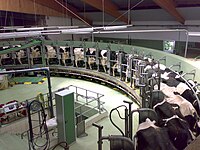
Photo from wikipedia
The insufficiency and variability of pasture production is a determining factor in milk production, particularly in the Sahelian zone. The objective of this study was to characterize dairy production systems… Click to show full abstract
The insufficiency and variability of pasture production is a determining factor in milk production, particularly in the Sahelian zone. The objective of this study was to characterize dairy production systems and their relationship with crops to meet livestock needs. It consisted of surveys of 120 farmers in four communes in the Séno province. The results show three groups of dairy farmers that are essentially differentiated by the main activity and the sex of the farmers as well as the size of the cattle herd on the farm. The first group is made of male agropastoralists, with herds averaging 12 cattle. Group 2 consists of male agropastoralists with an average of 22 cattle. Group 3 consists of female pastoralists (96.15%), with a herd size of about 19 head. The cows are fed on pasture and supplemented with crop residues and cottonseed cake. The supplementation is more important in group 2, where more farmers have hayloft for fodder conservation and manure pits compared to the other two groups. Crop residues are used primarily as feed in all groups from January to May. This supplementation allows the maintenance of milk production in the dry season and group 2, with more dairy cows, records more milk milked (6.5 and 3.8 l) and consumed in wet and dry seasons compared to the other two groups. The results suggest that the farmers in the area have low technical level and need capacity building in improved agro-pastoral production techniques to increase their production.
Journal Title: Tropical animal health and production
Year Published: 2022
Link to full text (if available)
Share on Social Media: Sign Up to like & get
recommendations!